 Science and Nature
Science and Nature

‘No take’ zones benefit whole reef
 (CNS): A study of no-take marine zones found that they not only help economically valuable species such as lobster, conch, and fish recover from overfishing, but may also help re-colonize nearby reef areas. The report from the Wildlife Conservation Society, represents a systematic review of research from no-take areas around the world, and comes as signatory countries of the Convention on Biological Diversity are being required to protect at least 10% of their marine territory.
(CNS): A study of no-take marine zones found that they not only help economically valuable species such as lobster, conch, and fish recover from overfishing, but may also help re-colonize nearby reef areas. The report from the Wildlife Conservation Society, represents a systematic review of research from no-take areas around the world, and comes as signatory countries of the Convention on Biological Diversity are being required to protect at least 10% of their marine territory.
The report, “Review of the Benefits of No-Take Zones” written by Dr Craig Dahlgren, a recognized expert in marine protected areas and fisheries management, was commisssioner by the WCS to describe the performance of no-take zones in Belize and in other countries to ultimately conserve highly diverse coral reef systems.
In many coastal marine ecosystems around the world, overfishing and habitatdegradation are prompting marine resource managers to find ecosystem-based solutions. The report also examines factors affecting the performance of no-take zones, such as the design, size, location, and factors of compliance with fishing regulations.
“Belize has been a leader in the region for establishing marine protected areas and has a world-renowned system of marine reserves, many of which form the Belize Barrier Reef Reserve System World Heritage Site,” said Janet Gibson, Director of the Wildlife Conservation Society’s Belize Program. “It’s clear that no-take zones can help replenish the country’s fisheries and biodiversity, along with the added benefits to tourism and even resilience to climate change.”
According to past studies, the recovery of lobster, conch, and other exploited species within marine protected areas with no-take zones, or fully protected reserves, could take as little as 1-6 years. Full recovery of exploited species, however, could take decades.
“The report provides a valuable guide for Belize’s marine managers and fishers,” said Dr Caleb McClennen, Executive Director of WCS’s Marine Program. “We also hope this effort will generate and sustain stakeholder support for these important regulatory tools.”

UK MP to press for no turtle meat for tourists
 (CNS): A British Conservative MP will be coming to the CaymanIslands next week to throw his political weight behind the campaign to persuade local restaurants not to sell turtle meat to visitors. A UK charity which is on a drive to transition the Cayman Turtle Farm (CTF) from a meat supplier into a purely conservation-based facility is taking aim at the tourism market as a starting point for reducing what demand exists for the meat. Matthew Offord, the Tory representative for Hendon in North London, will be hosting a reception here and also helping with the UK-based campaign to get the Conservative government to advise UK travellers at least not to eat the meat from the endangered species.
(CNS): A British Conservative MP will be coming to the CaymanIslands next week to throw his political weight behind the campaign to persuade local restaurants not to sell turtle meat to visitors. A UK charity which is on a drive to transition the Cayman Turtle Farm (CTF) from a meat supplier into a purely conservation-based facility is taking aim at the tourism market as a starting point for reducing what demand exists for the meat. Matthew Offord, the Tory representative for Hendon in North London, will be hosting a reception here and also helping with the UK-based campaign to get the Conservative government to advise UK travellers at least not to eat the meat from the endangered species.
Eating turtle in the UK is illegal and in the wake of a recent statement from the UK government advising visitors to Japan not to eat live sushi, World Animal Protection (formerly the World Society for the Protection of Animals) is hoping it can get similar support for a travel advisory along the same lines for eating turtle in Cayman.
Simultaneously, Offord and the WAP will be pressing restaurants here to voluntarily stop promoting the meat to tourists. So far, the Grand Old House is the first and only restaurant to remove turtle from its menu and has agreed to sell it only to locals who pre-order the dish.
Professor Neil D'Cruze from the WAP told CNS that he appreciates that a ban maybe difficult to implement but he is hoping to persuade more restaurants to take the meat off the menu altogether voluntarily or adopt the same position as the Grand Old House, where the campaign launch will be held. The charity also wants to persuade the Department of Tourism (DoT) to support the idea of at least not promoting the meat to visitors as it believes it stimulates a false and unnecessary demand.
Concerned that the CTF has no idea what the real demand for the meat is even from locals, D’Cruze said he was delighted to hear that the Department of Environment has received funding from the UK's department of food and rural affairs' Darwin Initiative to begin a comprehensive survey of that demand and research into the genetic profile of turtles nesting on the beaches to identify the connections of the local wild turtles to the Farm.
That project is unrelated to the WAP campaign and part of the DoE's broader research work into the endangered species and their survival in the wild. It is being led by Dr Ana Nuno from the University of Exeter and is expected to provide the first truly objective information about the origin of turtles that are breeding in local waters, as well as get a true assessment of how much demand there is for meat and the issues surrounding poaching.
The WAP maintains that the CTF slaughters animals without properly assessing demand and also keeps huge numbers of the animals without knowing the true level of consumption and whether it is necessary to breed so many. D'Cruze said that any figures that can give a truer picture of how much and how many local people do eat the meat may help reduce the numbers held at the farm.
Understanding that the effort to transition the facility to conservation will be a long process, he said that simply reducing the numbers held at the farm, which are estimated to currently be more than 9,000 animals, would be a step in the right direction.
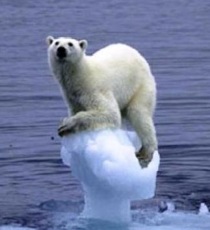
Global temperatures continue to break records
 (CNS): Climate experts said this week that it is getting hotter and hotter as the latest statistics reveal another increase in the average monthly temperature breaks records. June saw another global heat record 'hot' on the heels of the temperatures set in May. According to the National Oceanic and Atmospheric Administration (NOAA), the average global temperature in June was 61.2 degrees, which is 1.3 degrees higher than the 20th century average, and beat the record set in 2010 by 1/20 of a degree. Experts said the man in the street may think that sounds insignificant but “it’s like winning a horse race by several lengths” when it comes to temperature records, NOAA climate monitoring chief Derek Arndt said.
(CNS): Climate experts said this week that it is getting hotter and hotter as the latest statistics reveal another increase in the average monthly temperature breaks records. June saw another global heat record 'hot' on the heels of the temperatures set in May. According to the National Oceanic and Atmospheric Administration (NOAA), the average global temperature in June was 61.2 degrees, which is 1.3 degrees higher than the 20th century average, and beat the record set in 2010 by 1/20 of a degree. Experts said the man in the street may think that sounds insignificant but “it’s like winning a horse race by several lengths” when it comes to temperature records, NOAA climate monitoring chief Derek Arndt said.
The world’s ocean tempura turns were also on the increase breaking the monthly heat record at 62.7 degrees becoming the hottest the oceans for any average month and it is the oceans which are currently pushing up the air temperatures as well.
“We are living in the steroid era of the climate system,” Arndt added.
Although the United States had only its 33rd hottest June, heat records were broken in June on every continent but Antarctica. Particularly high temperatures were recorded in New Zealand, northern South America, Greenland, central Africa and southern Asia.
According to NOAA, the first six months of this year were the third warmest first six months on record, trailing 2010 and 1998. June was the 352nd hotter-than-average month in a row as determined by global temperature records dating back to 1880. All 12 of the world’s monthly heat records have been set since 1997, more than half of them in the last decade.
While global warming will be bad news for everyone in the end the first places to suffer will be low lying islands such as the Cayman Islands where bleaching and other problems will destroy our reefs but where rising sea levels will see increasing land erosion problems.

Dump fire continues controlled smolder
 (CNS): Although fire crews have the current George Town dump blaze under control the deep seated fire is still burning, officials have confirmed. The fire started at the landfill at the weekend Department of Environmental Health staff first noticed smoke on Saturday at around 10.30am in the solid waste area at the edge of the site. Fire crews and staff dug down some 200 feet to work on the fire and excavators were used to overturn debris. Since then teams from both DEH and the fire department have been working around the clock to contain the smoldering fire pouring on gallons of water.
(CNS): Although fire crews have the current George Town dump blaze under control the deep seated fire is still burning, officials have confirmed. The fire started at the landfill at the weekend Department of Environmental Health staff first noticed smoke on Saturday at around 10.30am in the solid waste area at the edge of the site. Fire crews and staff dug down some 200 feet to work on the fire and excavators were used to overturn debris. Since then teams from both DEH and the fire department have been working around the clock to contain the smoldering fire pouring on gallons of water.
Dr Maysson Sallam, the assistant director of the department of environmental health, notes that since the last such incident, deep wells have been placed around the landfill site allowing fire crews to access a continuous source of water and mange this and any other fire more efficiently.
The department has bought new water pumps which the assistant director said will be arriving on Island shortly. The department has also ordered other much-needed landfill equipment to helpoptimise operations. In addition, the department has in the interim rented two excavators that it can use to turn over the waste to help identify the source of heat.
While the fire continues senior DEH and fire officers with equipment are making regular visits to the scene. Osbourne Bodden, who has responsibility for the dump is currently in Scotland at the Commonwealth Games, however, he visited the landfill on Sunday 19 July but has made little comment about the situation. Bodden did however, urge the public to have patience as government moves through the necessary processes to find a sustainable solution for the waste management issue
The ministry has stated that it is making headway with the integrated solid waste management solution and a number of bids to develop the Cayman Islands first solid waste management strategy, an outline business case, and to provide procurement support for a solid waste management system, have been received and are being reviewed,.

Race on to save endangered Cayman corals
(CNS): Local and international marine experts are joining forces in the ocean around Little Cayman on an important conservation project to try and understand and then save endangered local coral species. The plight of the now critically endangered staghorn coral, which was once one of the most abundant corals on Caribbean reefs, is at the top of the agenda. A mysterious die-off starting in the 1980s resulted in a loss of almost 90% of the population. As a result both staghorn and elkhorn coral, in the genus Acropora, are listed as criticalely Endangered on the IUCN Red List of threatened species. The Central Caribbean Marine Institute and the Department of Environment have been using a grant from the Darwin Initiative to fund research on the biodiversity of coral and what they can do to increase this species.
This month, they begin a second phase which is simulating future potential stress to corals and other species.
“We are trying to understand how different corals might resist or adapt to changing ocean conditions” explains Dr Carrie Manfrino, a co-investigator with Tim Austin of the DoE on the Darwin grant. “In the first stage of the study, we have improved the odds of survival for the coral by testing different strategies for fragmenting the colonies. The second stage includes laboratory experiments simulating future increases in carbon dioxide in the ocean.”
With rising atmospheric carbon dioxide the oceans are absorbing a large share of this gas which results in a lowering of the ocean’s pH. This process is called Ocean Acidification.
“We are learning that certain areas of the reef might be more resistant to Ocean Acidification, but not for the reasons you might think. The current thinking is that sea grasses can absorb some of the carbon dioxide being pumped into the ocean because plants use CO2 during photosynthesis and give off oxygen. Currently, we suspect that higher night time respiration or lights out, no photosynthesis at night might be driving pH very high in lagoons where water circulation is stagnant.
"Having a very large range in pH – very acidic and very basic – seems to allow certain corals to thrive, while others suffer. The work is helping us understand interactions between ocean circulation and ocean acidification in a real world setting,“ explained Manfrino.
The research team currently in residence at Little Cayman Research Centre is working to understand how to improve the survival of corals under stress.
Protecting coral reefs for the future is CCMI’s most urgent mission, the officials said. With many factors contributing to the global decline in coral health, understanding interactions between water quality, wave exposure, human impacts, and the differences in the adaptability of corals is a continuing priority. CCMI’s research aims to determine which of these many factors are of important to driving coral resistance to stress.
This Darwin Initiative project in the Cayman Islands comes at a time when recent publication by the International Union for Conservation of Nature (IUCN) and the United Nations Environment Programme (UNEP) throw new light on the state of coral reefs.
The “Status and Trends of Caribbean Coral Reefs: 1970-2012” report indicates that coral reef ecosystems in the Caribbean could be wiped out by 2035 without proper marine management and protection of endangered species. However, despite this overall downward trend coral cover, some reefs in the Cayman Islands are actually improving. Understanding the factors driving this recovery is obviously an urgent priority.
"We see a positive trajectory in coral cover since 2009 suggesting that low human impact and higher levels and larger areas of marine protection at Little Cayman may offer reefs some potential for buffering the effects of global change. However, we will need to examine specific factors that support coral recovery," added Manfrino.

Drivers urged to watch out for crabs crossing roads
 (CNS): At this time of year the roads tend to be crowded by large numbers of crabs trying to reach the beach but he Department of Environment says that by driving slowly in these areas people can warn the crabs and give them time to get out of the way, or drivers can time to drive over or around them without hitting them. The police are urging drivers to take safety precautions during crab season, including parking vehicles at the side of the road with their parking lights and emergency flashers on, and reminding them not to rapidly swerve their vehicles to avoid running over crabs on the road as this evasive action could cause drivers to lose control of their vehicles and cause an accident. Left: Red Shank (Geocarcinus lateralis)
(CNS): At this time of year the roads tend to be crowded by large numbers of crabs trying to reach the beach but he Department of Environment says that by driving slowly in these areas people can warn the crabs and give them time to get out of the way, or drivers can time to drive over or around them without hitting them. The police are urging drivers to take safety precautions during crab season, including parking vehicles at the side of the road with their parking lights and emergency flashers on, and reminding them not to rapidly swerve their vehicles to avoid running over crabs on the road as this evasive action could cause drivers to lose control of their vehicles and cause an accident. Left: Red Shank (Geocarcinus lateralis)
According to the DoE, the Cayman Islands are home to various species of land crabs which, although they have successfully invaded the land, are all still seasonally dependent on the sea. Most residents are familiar with “crab season” throughout July and August and this phenomenon is due to the fact that all land crab species cross the roads to get to the sea during the breeding season.
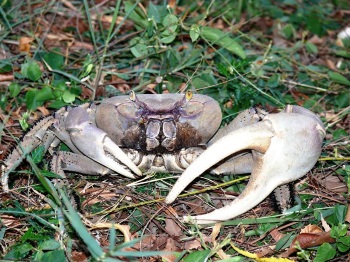 The reproductive cycles of, for example, the White Land Crab (Cardisoma guanhumi) (right: male with an obviously enlarged claw) and the Black Land Crab (Geocarcinus ruricola) (below) — both traditionally harvested for food and the later of whose colour can vary from yellow to dark purple — are closely linked to seasonal weather patterns and lunar phases and migrations are often initiated by heavy rains. For the first few weeks of the migratory period the crabs increase their foraging and gain weight rapidly.
The reproductive cycles of, for example, the White Land Crab (Cardisoma guanhumi) (right: male with an obviously enlarged claw) and the Black Land Crab (Geocarcinus ruricola) (below) — both traditionally harvested for food and the later of whose colour can vary from yellow to dark purple — are closely linked to seasonal weather patterns and lunar phases and migrations are often initiated by heavy rains. For the first few weeks of the migratory period the crabs increase their foraging and gain weight rapidly.

Males actively court females which then carry external egg masses on the underside of their bodies after mating. The eggs are carried for approximately two weeks prior to hatching and will eventually be released into the sea to ensure survival and larval development. The spawning migrations are typically completed within 1-2 days and the spawning takes place within 1-2 days of a full moon.
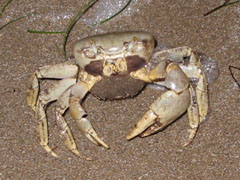
The White Land Crab is slow-growing compared to most other crabs, reaching sexual maturity only after approximately 4 years and large individuals may grow to over four inches across and over 1 pound in weight. This highlights the importance of letting the crabs reproduce when they embark on their spawning migrations. It is highly recommended that females are left alone if eggs are seen on the underside of their bodies (see picture right) so they can spawn and secure the return of many more juvenile land crabs. Females and males are generally easy to tell apart as males are larger and have a noticeably enlarged claw (cheliped).
For more information on the land crabs please visit the DoE website and the Land Crab Species Action Plan.
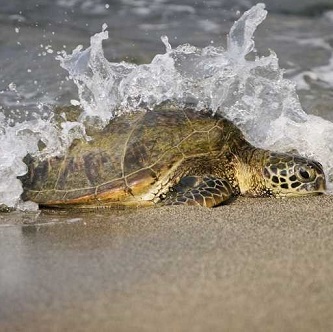
US sets aside 100s of miles of beach for turtles
 (CNS): The United States federal government has extended protection to loggerhead sea turtles nesting on Florida beaches, according to the US media. Hundreds of miles of coastline and ocean was designated critical habitat this week including beaches in Broward and Monroe counties. The areas, which cover 685 miles of nesting beach and more than 300,000 square miles of ocean, mark the largest critical habitat distinction in history, said Amanda Keledjian, a marine scientist at Oceana, an ocean conservation organization. Species with protected critical habitat are twice as likely to recover than species without protection, Keledijian said.
(CNS): The United States federal government has extended protection to loggerhead sea turtles nesting on Florida beaches, according to the US media. Hundreds of miles of coastline and ocean was designated critical habitat this week including beaches in Broward and Monroe counties. The areas, which cover 685 miles of nesting beach and more than 300,000 square miles of ocean, mark the largest critical habitat distinction in history, said Amanda Keledjian, a marine scientist at Oceana, an ocean conservation organization. Species with protected critical habitat are twice as likely to recover than species without protection, Keledijian said.
The sea turtles will use their newly designated coastline and ocean space for nesting and feeding.
In areas designated as critical habitat by the National Oceanic and Atmospheric Administration’s National Marine Fisheries Service and the U.S Fish and Wildlife Service, federal projects must be evaluated for potential harm to endangered species. Projects may include building highways, oil exploration or shipping, Keledjian said.
While the distinction is meaningful at the federal level, beachgoers are unlikely to notice any change.
Read more in the Miami Herald
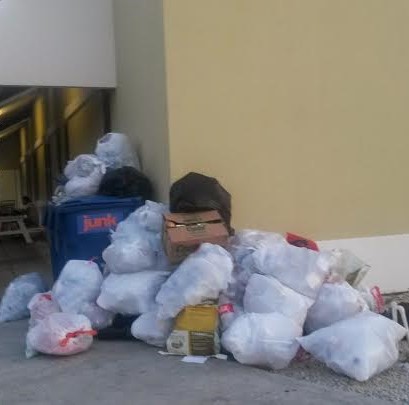
Recycling demand mounting
 (CNS): A private waste removal project which began as a subsidized recycling programme for plastics, cardboard, paper, glass and aluminium is being overwhelmed with the amount of recyclable goods being placed in bins at local supermarkets. With government recycling only cans, Junk, began a pilot project in partnership with supermarkets and local service clubs to create drop-off points but the demand is tremendous and the small business, which is underwriting much of the cost, is struggling to keep up with collections. Meant to be a once a week pick-up, Junk has had to increase these free community collections to three or four times a week but it’s still not able to collect the quantity of sorted waste being left at stores as quickly as it would like.
(CNS): A private waste removal project which began as a subsidized recycling programme for plastics, cardboard, paper, glass and aluminium is being overwhelmed with the amount of recyclable goods being placed in bins at local supermarkets. With government recycling only cans, Junk, began a pilot project in partnership with supermarkets and local service clubs to create drop-off points but the demand is tremendous and the small business, which is underwriting much of the cost, is struggling to keep up with collections. Meant to be a once a week pick-up, Junk has had to increase these free community collections to three or four times a week but it’s still not able to collect the quantity of sorted waste being left at stores as quickly as it would like.
A spokesperson from the firm, which is owned in part by MLA Winston Connolly, said that some people are also leaving non-recyclables at the supermarket locations where Junk leaves recycle bins, adding to the workload, which is becoming difficult for the small business to sustain.
Although the supermarkets are offering the space for the skips and bins free and some are sharing the cost of those bins, Junk is absorbing most of the gas costs for the service. But demand is growing by the week and it is seeking more partners from local service clubs and other organisations to try and cover the costs of the private sector effort to recycle inthe absence of any meaningful programme by the Department of Environmental Health.
“Even though a number of our recyclables are actually collected at a loss, as a company, we have chosen to lead by example and take a very long term approach to recycling in Cayman,” a spokesperson for Junk told CNS. “It is our hope that along with the community, government policy and recycling legislation that others will join in and share the burden. It's the only way we can contribute to reducing what goes into the landfill and do our part to keep Cayman green."
The piles of plastics, cardboard, glass and cans sorted by residents who are keen to see their waste recycled and reused are growing steadily as more people begin to separate their rubbish but with DEH not collecting recyclables other than cans, Junk is going it alone and struggling to keep pace.
“We perform the services at the supermarket sites at significantly reduced costs and not reflective of our normal rates,” the Junk spokesperson added, explaining that as well as being a community service it allows people to see that private sector recycling at least exists in Cayman.
With the success of the programme in terms of getting people to recycle, the next step now is to come up with solutions to the growing piles and prevent regular garbage being mixed with the recyclables.
“We have come up with some solutions that hopefully are cost effective and that will save us time in sorting and processing as well as improve the aesthetics on the sites,” the firm said. “It will require everyone doing their part: community, store owners and Junk and we feel it can be done if people are committed and we all take recycling seriously and have thought about what happens after the items are deposited at the sites.”
The spokesperson is hoping to get residents to use recycling bags with $3 junk stickers per bag so that the firm only collects properly bagged and sorted recyclables. “We have had incidents where people put bottles in a cardboard box, other people come and put garbage on the bottles, it rains and when the drivers go to collect the bottles, they are mixed with garbage or have cigarette butts stuffed in them and the box breaks apart. Residents also, in spite of recycling stickers, dump regular garbage in the bins, or put wet items into cardboard bins which has resulted in wasted bins that we have to actually deliver to the landfill, defeating the goal.”
The Junk spokesperson said the firm has dealt with community complaints relating to the unsightliness of the sites at times and he said the firm has tried to explain what it can and can't collect and why people need to do their part as well.
“It's not fair to the stores providing the space; it's not fair to the sorters who collect the recyclables and it adds to the operating costs as we have to wash and separate recyclables again, and that's after we have given 75% mark downs on our services, or even spoiling the recyclables,” the spokesperson said. “We will continue to work on educating the public and ask that they please be patient as we strive to push full recycling in Cayman and revolutionize the industry.
“The irony is what was originally conceived as an introductory community project with Rotary Sunrise Grand Cayman has been overwhelmingly subscribed by the community and we have moved into the second stage of the project which is public education on recycling, including a schools programme,” he added.
The firm also have recently launched the Pink Periwinkle Bin project, where earmarked fees will go to the Cayman Islands Cancer Society or the Breast Cancer Foundation and Junk delivers anything usable to charities across the island. It is also in talks to launch in Cayman Brac shortly and has begun an audit in Little Cayman with the intent of making it a green island with a coordinating partner there.
“We believe that we can achieve great things. We need community partners to come on board and support us. We are willing to work with anyone on this cause. We are a small but ambitious company who thinks we can,” the spokesperson said.
With Cayman seemingly ready for recycling and the much anticipated dump solution still more than 18 months away, the local supermarkets are in danger of becoming swamped in recycling but Junk said they are confident things can be more organised and efficient.
Having created the Cayman Islands National Waste and Recycling Association to further promote and educate and handle the sponsorships of the bins, the junk management team said they want to transfer this to the service clubs or interested community members to take over. Lobbying for recycling legislation and standards whilst promoting a cleaner Cayman, Junk is hoping other people will become members to further the goals of the association.
Anyone interested in sorting their own waste and recycling can drop it off at the Junk bins at most of the supermarkets, including Chisholm’s in North Side and Camana Bay. Recyclers can also drop sorted items to the firm’s offices at #15A Kingbird Drive, North Sound Road.
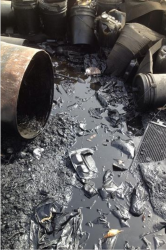
DEH mops up Brac oil leak

(CNS): An oil spill at the Brac dump last week was from the used oil at the site that had been stored in deteriorating 5-gallon buckets and 55-gallon drums that were open and partially filled. According to the director of the Department of Environmental Health (DEH), who personally supervised the clean-up, there was evidence that the drums were “knocked or tipped over, either accidentally or deliberately, and those oils significantly contributed to the oil spill on site”. Roydell Carter said that some of the small plastic containers had started to deteriorate and leak but did not contribute significantly to the oil spillage. Photos of a thick layer of oil seeping directly into the ground were taken by Brac resident Dalkeith Ebanks. CNS send the pictures on to Carter and the minister responsible, Osbourne Bodden, and Deputy Premier Moses Kirkconnell, who has responsibility for the Sister Islands.
The next day, Thursday 3 July, the DEH director travelled to Cayman Brac to supervise the clean-up, along with the DEH foreman of recycling operations. Working with the DEH’s Brac team and an un-named private company, the spilled oil and soil was collected and placed in a separate area of the landfill for further processing.
“All of the remaining used oils in the small containers were transferred to new 55-gallon drums and secured on site. The area now has new soil material in place,” he stated.
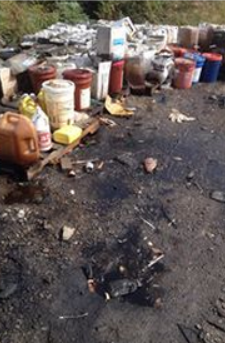 Explaining how this could have happened, Carter said that, in addition to the poor storage conditions, the used oils were being stored on a sloped area, "which caused the spilled oils to accumulate in a designated area making the clean-up process fairly straight forward without any difficulty.” However, he admitted that there was “definitely room for improvements in the landfill operations and recycling programmes on the Sister Islands” and said that the staff would also undergo necessary training to improve operations.
Explaining how this could have happened, Carter said that, in addition to the poor storage conditions, the used oils were being stored on a sloped area, "which caused the spilled oils to accumulate in a designated area making the clean-up process fairly straight forward without any difficulty.” However, he admitted that there was “definitely room for improvements in the landfill operations and recycling programmes on the Sister Islands” and said that the staff would also undergo necessary training to improve operations.
DEH staff do monitor the site periodically, he maintained, but members of the public can bring in used oils at any time in any kind of container.
“The public can also tamper with what is on site since the landfill is unsecured at this time. Staff were aware that some containers had unsecured covers and others had secured lids but may develop slow leaks,” he said. “As previously mentioned it appeared that some used oil containers were recently knocked over or tipped over, whether deliberately or accidently.”
The director said that the DEH will make some additional improvements to the used oil storage on the Brac, which will include using a different storage area at the landfill, proper signage, use of recently acquired purpose-built oil storage and shipping tanks that can hold about 350 gallons of used oils, and transfer of the used oils when the containers are full.
“All used oils brought to the landfill site by the public in improper containers will be transferred on a regular basis to the new used old storage and shipping tanks that will soon be on site,” he said. “Meanwhile, used oils will continue to be temporarily stored in good quality 55-gallon drums that can be secured to prevent oil spillage.”
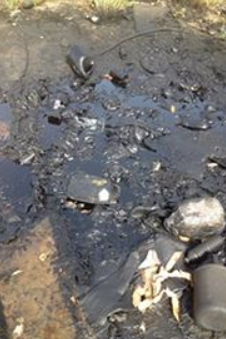 There is a used oil programme for the Sister Islands where the accumulated oil is shipped once or twice a year to Grand Cayman, Carter explained. The shipment frequency depends on used oil volumes but generally the used oils are transferred between June and July. He said the oil now at the Brac site was placed there by the public since removal last year.
There is a used oil programme for the Sister Islands where the accumulated oil is shipped once or twice a year to Grand Cayman, Carter explained. The shipment frequency depends on used oil volumes but generally the used oils are transferred between June and July. He said the oil now at the Brac site was placed there by the public since removal last year.
“The DEH has a plan in place to remove all used oils on site this month since the new budget has been approved and this will be an ongoing programme,” the director stated.
“The DEH recycling team has already transferred the used oils at the site into new sturdy 55-gallon drums in preparation for transfer to Grand Cayman this month for further processing, where the old will be tested and combined with the other oil supplies for final shipment off-island to a recycling facility in the United States. All used oils on the Sister Islands will be shipped to Grand Cayman for further processing,” he said.
“The DEH would like the Brac public not to interfere with the oil storage area or remove any items from the landfill site as in the process they may cause an accident, spillage as they may be hurt or injured in the process if the items are not properly secured,” Carter said.
In addition, he said there would be further education of the Cayman Brac public about recycling and the need to properly store oil on the site. The plans, he said, may include closing the landfill to the public after certain hours to enable better management control of the site and to reduce and prevent incidents from occurring when the site is unattended.”
Asked about Little Cayman, he said there is a secured used oil storage area on that island which does not have any problems.
“There is definitely room for improvements in the landfill operations and recycling programmes on the Sister Islands and the public will see and hear more about the procedures and programmes this year,” he stated.

First TS of season becomes first hurricane
(CNS): Tropical Storm Arthur became Hurricane Arthur at around 5:00am on Thursday as it headed north off the coast of South Carolina towards the neighbouring state of North Carolina. Located at around 300 miles southwest of Cape Hatteras, the storm is moving at around 9mph with winds in excess of 80mph. Forecasters are predicting that the season's first hurricane, just one month in, will turn toward the northeast and increase in speed and intensity later today and Friday. Arthur is expected to approach the coast in the warning area tonight. Hurricane-force winds extend up to 25 miles and tropical-storm-force winds extend outward up to 90 miles from the centre. For more details visit the NHC website.